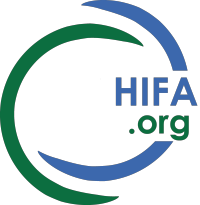Dear HIFA colleagues,
HIFA member Onikepe Owolabi is the lead author of a paper in this month's WHO Bulletin (December 2024). Onikepe previously volunteered with HIFA as an MPH student in Oxford in 2014, when she led our HIFA Project on Traditional Birth Attendants, leading to the publication of 'Stakeholder views on the incorporation of traditional birth attendants into the formal health systems of low-and middle-income countries: a qualitative analysis of the HIFA2015 and CHILD2015 email discussion forums' https://bmcpregnancychildbirth.biomedcentral.com/articles/10.1186/1471-2...
Onikepe has since had a stellar career and she is now the Director of International Research at the Guttmacher Institute.
Below are the citation, abstract , selected extracts and a comment from me.
CITATION: Progress towards sustainable development goals related to sexual health
Onikepe O Owolabi, Jonathan Hopkins, Akinrinola Bankole, Jonathan Bearak
WHO Bulletin, December 2024
https://pmc.ncbi.nlm.nih.gov/articles/PMC11601179/?report=classic
ABSTRACT
Achieving the sexual health components of sexual and reproductive health and rights as outlined in the sustainable development goals (SDGs) is integral to overall physical and mental well-being and a core part of universal health coverage. However, tracking national and global progress towards advancing the sexual health and rights of people is challenging because of the paucity of indicators to examine many of its components. To assess the state of sexual health in populations, determine service provision needs, evaluate the effectiveness of health system interventions and monitor progress in optimizing health, a comprehensive set of indicators is needed to cover every component of sexual health. Without comparable global indicators for each component of sexual health across the individual, health systems and policy levels, and disaggregated across subgroups including all genders, there is a considerable lack of insight into people’s sexual health needs and progress towards meeting those needs. This article explores the availability of global indicators for the different components of sexual health by analysing two key sources: the global indicator framework of the SDGs and the indicator index of the Global Health Observatory. We summarize the indicators for each component of sexual health using the Guttmacher–Lancet Commission framework, highlighting gaps in current indicators, and recommend areas where additional indicators are needed along with strategies on how to improve data availability, quality and inclusiveness.
SELECTED EXTRACTS
'Table 1. The components of sexual health and reproductive health.
Comprehensive sexuality education Accurate information and counselling on sexual and reproductive health, including evidence-based, comprehensive sexuality education
Sexual health and well-being Information, counselling and care related to sexual function and satisfaction...'
'Comprehensive sexuality education
'SDG Number of countries with laws and regulations that guarantee full and equal access to women and men aged 15 years and older to sexual and reproductive health care, information and education (5.6.2)
'SDG Proportion of women aged 15–49 years who make their own informed decisions regarding sexual relations, contraceptive use and reproductive health care (5.6.1)
'SDG Number of countries with laws and regulations that guarantee full and equal access to women and men aged 15 years and older to sexual and reproductive health care, information and education (5.6.2)'
'We identified seven (10%) sexual health and well-being indicators (four SDG indicators and three from the Global Health Observatory). They include child marriage; female genital mutilation and/or cutting; the ability of women to make informed decisions regarding sexual relations, contraceptive use and reproductive health care; and laws and regulations that guarantee access to sexual health care.'
'Most sexual health indicators from these sources relate to sexually transmitted infections and gender-based violence, primarily focusing on the prevalence or incidence of disease or infirmity. Notably, comprehensive sexuality education is not measured at the individual level, with no data on the proportion of young people who have sexual health knowledge or access to such information.'
'Additionally, despite the importance of education and information for awareness of sexual health needs and access to services, comprehensive sexuality education is almost absent among the available indicators.'
'Although accurate information is important for the awareness of sexual health needs and access to services, the number of indicators routinely collected is currently unequal between the five components of sexual health. New measures should focus on not only the type of education and information available but also on the sources of information. This approach is particularly important in today’s digital environment, where unverified information is increasingly accessible through social media.'
COMMENTS (NPW):
1. HIFA stands ready to develop a new HIFA Project in 2025 to support efforts to ensure universal access to reliable SRH information, subject to modest funding.
2. The global sexual and reproductive health (SRH) community is at the forefront of global efforts to improve the availability and use of reliable healthcare information and we have much to learn from them. It is the *only* health sector to have access to reliable healthcare information specifically recognised in the Sustainable Development Goals. This is almost certainly because the SRH community is stronger and better organised than other sectors. The challenge for us now is how to get access to reliable healthcare information recognised across *all* areas of global health. One way to enable this (as we found in the HIFA Global Consultation) would be for WHO to explicitly champion universal access to reliable healthcare information and to convene stakeholders to develop a global strategy (an obvious component of such a strategy would be to include universal access in the SDGs).
3. The HIFA Evaluation working group stands ready to build on the successes of the SRH community to develop our work on indicators of healthcare information and their inclusion in future global health goals.
Best wishes, Neil
HIFA profile: Neil Pakenham-Walsh is coordinator of HIFA (Healthcare Information For All), a global health community that brings all stakeholders together around the shared goal of universal access to reliable healthcare information. HIFA has 20,000 members in 180 countries, interacting in four languages and representing all parts of the global evidence ecosystem. HIFA is administered by Global Healthcare Information Network, a UK-based nonprofit in official relations with the World Health Organization. Email: neil@hifa.org

